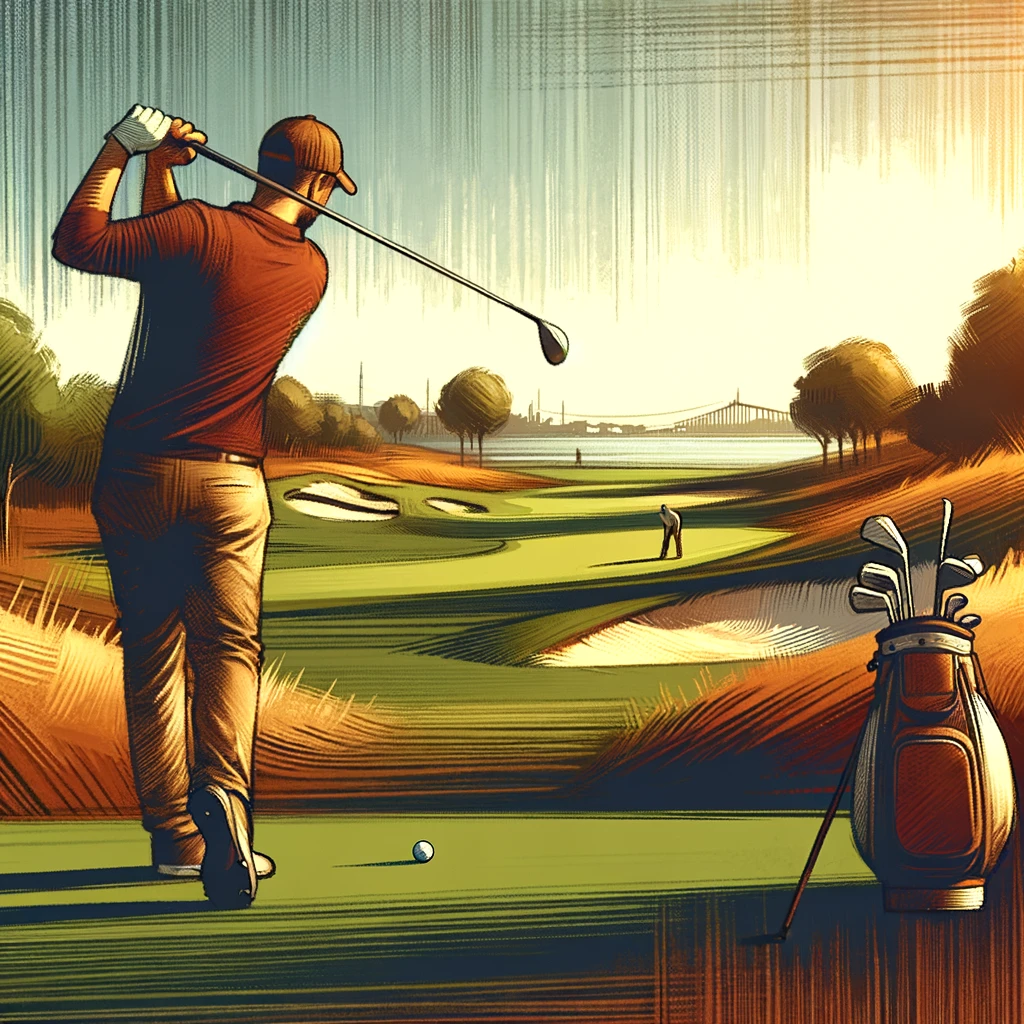How to Drive a Golf Ball: Mastering the Perfect Drive
Driving a golf ball can be challenging, but with the right techniques, you can significantly improve your game. In this guide, you'll discover key tips and actionable steps on how to perfect your stance, master the backswing, execute the perfect downswing, and nail the follow-through. Whether you're a beginner or looking to refine your skills, our comprehensive guide will help you achieve longer and more accurate drives. Don't miss the key takeaways and FAQ section at the bottom for quick insights and answers to common questions.
Are you frustrated with your inconsistent golf drives, wondering why your shots are all over the place while others seem to effortlessly hit long, straight drives? I completely understand that feeling. The confusion, the missed opportunities, and the sheer disappointment after a poor swing can be overwhelming. It’s easy to get caught up in the mechanics and lose sight of the joy of the game. But don't worry, you're not alone, and there’s a way to transform your golfing experience.
I was once in your shoes, struggling to achieve the perfect drive, feeling stuck despite hours of practice. It wasn’t until I discovered a structured approach to mastering the golf drive that everything changed. By focusing on the key elements of stance, backswing, downswing, and follow-through, I was able to break down the complexity into manageable steps. This not only improved my performance but also reignited my passion for golf. I want to share this journey with you so you can experience the same transformation.
Imagine stepping onto the tee with confidence, knowing exactly what to do to achieve that perfect drive. No more second-guessing, no more frustration—just pure satisfaction from seeing the ball soar down the fairway. This guide will walk you through the essential techniques and tips that helped me, and many others, improve our golf drives. Let's embark on this journey together, so you can enjoy the game and hit those drives like a pro.
 Perfect your golf drive with these tips.
Perfect your golf drive with these tips.My Journey to Mastering the Golf Drive
When I first picked up a golf club, driving the ball felt like an insurmountable challenge. No matter how hard I tried, my shots were inconsistent, and I struggled to achieve the distance and accuracy I desired. I remember feeling frustrated and questioning whether I would ever be able to master this essential aspect of the game.
Determined to improve, I embarked on a journey to understand the mechanics of a perfect golf drive. I spent countless hours reading articles, watching tutorials, and practicing at the driving range. Despite my efforts, progress was slow, and I realized I needed a more structured approach to truly enhance my skills.
My breakthrough came when I discovered a new opportunity to transform my golf drive through a comprehensive framework. This framework was not just about swinging the club harder but involved understanding the key elements of stance, backswing, downswing, and follow-through. It provided a step-by-step guide that was easy to follow and implement.
The framework I adopted included:
- Perfecting the Stance and Setup: Ensuring proper foot positioning, weight distribution, and ball alignment.
- Mastering the Backswing: Focusing on a low and wide takeaway, weight shift, and shoulder rotation.
- Executing the Perfect Downswing: Initiating with the lower body, maintaining a square clubface, and controlling the tempo.
- Nailing the Follow-Through: Completing the swing with full body rotation and a balanced finish.
This structured approach allowed me to break down the complex process of driving a golf ball into manageable steps.
Through diligent practice and applying this framework, my driving skills improved dramatically. I went from inconsistent shots to hitting long, straight drives with confidence. This transformation not only enhanced my game but also reignited my passion for golf. Now, I enjoy the game more than ever and am excited to share these insights with others who are on a similar journey.
"Success in this game depends less on strength of body than strength of mind and character." - Arnold Palmer
1. Perfecting Your Stance and Setup
Foundation of a Great Drive
Your stance is the foundation of a powerful and accurate drive. Here’s how you can set up for success:
- Feet Positioning: Stand with your feet shoulder-width apart. This provides a stable base.
- Weight Distribution: Keep your weight evenly distributed with a slight bias towards your back foot. This helps in maintaining balance and power during the swing.
- Ball Positioning: Align the ball with your left heel (for right-handed golfers). This ensures you hit the ball on the upswing, which is crucial for maximizing distance.
- Body Posture: Slightly bend your knees and tilt your spine forward from the hips. Your arms should be extended but relaxed, with hands just ahead of the ball.
When I first started golfing, I struggled with my stance. My feet were too close together, and I often found myself off balance. After much practice and a few tips from seasoned golfers, I adjusted my stance, and the improvement was almost immediate.
Key Tips for Finding the Right Stance:
1. Use an Alignment Stick: This helps ensure your feet are properly aligned with your target.
2. Maintain a Comfortable Posture: Avoid tension as it can disrupt your swing.
3. Practice Regularly: Consistency is key to ingraining the proper stance.
By perfecting your stance and setup, you'll create a strong foundation that allows for more powerful and accurate drives. It’s a small adjustment that can make a big difference in your game.
 Master the art of driving a golf ball.
Master the art of driving a golf ball.2. Mastering the Backswing
The Importance of a Good Backswing
The backswing is crucial in setting up the rest of your swing. Here’s how to execute it properly:
- Keep it Low and Wide: Start your backswing by sweeping the club back low to the ground. This helps maintain a wide arc, which is essential for generating power.
- Shift Your Weight: As you bring the club back, shift your weight to your back leg. This creates a strong base and allows for a powerful downswing.
- Hinge Your Wrists: At the top of your backswing, ensure your wrists are fully hinged. This helps store energy that will be unleashed during the downswing.
- Rotate Your Shoulders: Make a full shoulder turn while keeping your lower body stable. Your back should face the target at the top of the swing.
When I first began practicing my backswing, I often forgot to hinge my wrists, resulting in weak shots. It wasn’t until a coach pointed this out that I started seeing improvement. Keeping my left arm straight and focusing on a full shoulder turn made a significant difference.
Key Tips for Improving the Backswing:
1. Use a Mirror: Practice in front of a mirror to ensure your form is correct.
2. Slow Practice Swings: Focus on the mechanics without worrying about the ball.
3. Visualize the Swing: Picture the entire backswing and follow-through in your mind.
By mastering the backswing, you set up the foundation for a powerful and accurate drive. This step is about precision and control, ensuring that your body moves in sync to create the perfect shot.
3. Executing the Perfect Downswing
Transitioning to the Downswing
The downswing is where all the power and precision from your setup and backswing come together. Here’s how to execute it correctly:
- Start with Your Lower Body: Initiate the downswing by shifting your weight from your back foot to your front foot. This weight transfer is crucial for generating power.
- Rotate Your Hips and Torso: As you shift your weight, rotate your hips and torso towards the target. This helps maintain a smooth and powerful swing path.
- Keep Your Arms and Club in Sync: Your arms should follow the motion of your body, swinging the club down and through the ball. Avoid using just your arms to hit the ball; this can lead to slices and hooks.
- Maintain a Square Clubface: Ensure your clubface is square to the target line at impact. This helps in achieving a straight and accurate shot.
I remember the first time I really focused on my downswing technique. It felt like everything clicked into place. By starting with my lower body and ensuring my hips and torso led the swing, I noticed a significant increase in both power and accuracy.
Key Tips for Improving the Downswing:
1. Use a Slow, Steady Tempo: Rushing the downswing can lead to poor contact. Focus on a smooth, controlled motion.
2. Practice with a Mirror: Watching your form in a mirror can help ensure you're rotating correctly.
3. Focus on Balance: Maintaining balance throughout the downswing is crucial for consistency.
By mastering the downswing, you’ll be able to generate more power and hit the ball with greater accuracy. This step is all about coordination and ensuring your body works together to create a fluid motion.
 Achieve long and straight drives with these tips.
Achieve long and straight drives with these tips.4. Nailing the Follow-Through
Finishing Strong with a Solid Follow-Through
The follow-through is not just about looking good; it’s a crucial part of ensuring that your drive is powerful and accurate. Here’s how to perfect it:
- Complete Body Rotation: Ensure your body rotates fully through the shot, with your weight shifting onto your front foot. This helps generate maximum power and ensures a good follow-through.
- Relax Your Arms: Allow your arms and hands to extend naturally towards the target. This helps in maintaining balance and control.
- Stable Finishing Position: Aim to finish with your chest facing the target and your club pointing upwards. Your back heel should be off the ground, and your weight should be fully on your front foot.
When I focused on my follow-through, I realized it wasn’t just the end of the swing but an integral part of the entire process. By ensuring a full body rotation and a balanced finish, I found my drives became both longer and more accurate.
Key Tips for Improving the Follow-Through:
1. Focus on Rotation: Make sure your body is fully rotating through the shot.
2. Maintain Balance: Keep a stable finishing position to ensure consistency.
3. Practice with Purpose: Work on your follow-through with each practice session to make it a natural part of your swing.
By nailing the follow-through, you’ll ensure that all the power and precision built up during the swing are effectively transferred to the ball. This step is about finishing strong and maintaining balance throughout your swing.
5. Avoiding Common Mistakes
Common Pitfalls and How to Overcome Them
Even experienced golfers can fall into bad habits. Here are some common mistakes and how to avoid them:
- Open Clubface: A weak grip can leave the clubface open at impact, causing a slice. Strengthen your grip by rotating your hands slightly away from the target.
- Poor Swing Path: Compensating for an open or closed clubface by altering your swing path can lead to inconsistency. Focus on maintaining a proper swing path and correcting your clubface first.
- Narrow Stance: Using a narrow stance reduces power and stability. Ensure your feet are shoulder-width apart to maintain balance and control.
- Ball Too Far Back: Positioning the ball too far back can lead to hitting down on it, resulting in increased spin and reduced distance. Align the ball with your left heel for optimal contact.
When I first started playing, I often struggled with a slice. After analyzing my grip and swing path, I realized my clubface was frequently open at impact. Adjusting my grip and practicing with alignment sticks helped me correct this issue.
Tips for Avoiding Common Mistakes:
1. Check Your Grip: A proper grip is fundamental to maintaining a square clubface.
2. Use Alignment Aids: Tools like alignment sticks can help ensure your swing path and stance are correct.
3. Regular Practice: Consistent practice helps identify and correct bad habits.
By being aware of these common mistakes and taking steps to correct them, you can improve your consistency and accuracy on the course. This section is about understanding and overcoming the pitfalls that can hinder your performance.
 Drive the golf ball like a pro on a beautiful course.
Drive the golf ball like a pro on a beautiful course.6. Utilizing Practice Tips
Making Practice Count
Effective practice is essential for improving your golf drive. Here are some tips to make the most out of your practice sessions:
- Set Specific Goals: Identify areas where you need improvement and set clear, achievable goals. This could be anything from correcting your stance to improving your follow-through.
- Use Drills and Training Aids: Incorporate drills and training aids into your practice. Tools like alignment sticks, weighted clubs, and swing trainers can help you refine your technique.
- Practice Regularly: Consistency is key. Regular practice helps build muscle memory and improves your overall game.
- Simulate Game Conditions: Practice under different conditions to prepare for real game scenarios. This includes varying weather conditions and different types of courses.
- Analyze Your Performance: Use video analysis to review your swings. This can help you identify areas for improvement and track your progress over time.
I remember dedicating time each week to practice specific aspects of my swing. Using training aids like alignment sticks and weighted clubs helped me focus on my weaknesses and turn them into strengths. Over time, I saw noticeable improvements in my drives.
Tips for Effective Practice:
1. Create a Routine: Establish a regular practice routine that covers all aspects of your drive.
2. Stay Focused: Avoid distractions and concentrate on the task at hand during practice sessions.
3. Track Progress: Keep a practice journal to record your goals, drills, and progress.
By making practice a regular part of your routine and using these tips, you can see significant improvements in your golf drive. This section is about developing a practice regimen that works for you and helps you achieve your golfing goals.
Key Takeaways: How to Drive a Golf Ball
Driving a golf ball effectively is a skill that can be developed with the right techniques and consistent practice. Here are the core actionable takeaways you can use immediately:
1. Perfect Your Stance and Setup:
- Feet Positioning: Stand with your feet shoulder-width apart. It provides a stable base, which means you can balance better during your swing.
- Weight Distribution: Keep your weight evenly distributed with a slight bias towards your back foot. It helps maintain balance, which means more power in your swing.
- Ball Positioning: Align the ball with your left heel. It ensures you hit the ball on the upswing, which means maximizing distance.
- Body Posture: Slightly bend your knees and tilt your spine forward. It creates the right angle for your swing, which means better contact with the ball.
2. Master the Backswing:
- Keep it Low and Wide: Start your backswing by sweeping the club back low. It maintains a wide arc, which means generating more power.
- Shift Your Weight: As you bring the club back, shift your weight to your back leg. It creates a strong base, which means a powerful downswing.
- Hinge Your Wrists: Fully hinge your wrists at the top of your backswing. It stores energy, which means unleashing it during the downswing.
- Rotate Your Shoulders: Make a full shoulder turn. It engages your entire body, which means a more powerful swing.
3. Execute the Perfect Downswing:
- Start with Your Lower Body: Initiate the downswing by shifting your weight from your back foot to your front foot. It generates power, which means a stronger drive.
- Rotate Your Hips and Torso: As you shift your weight, rotate your hips and torso towards the target. It ensures a smooth swing path, which means better accuracy.
- Keep Your Arms and Club in Sync: Let your arms follow the motion of your body. It prevents slices and hooks, which means more consistent shots.
- Maintain a Square Clubface: Ensure your clubface is square to the target line at impact. It helps achieve a straight shot, which means improved accuracy.
4. Nail the Follow-Through:
- Complete Body Rotation: Rotate fully through the shot. It generates maximum power, which means longer drives.
- Relax Your Arms: Let your arms extend naturally towards the target. It maintains balance, which means better control.
- Stable Finishing Position: Finish with your chest facing the target. It ensures a balanced stance, which means more consistent performance.
5. Avoid Common Mistakes:
- Open Clubface: Strengthen your grip to keep the clubface square. It prevents slicing, which means straighter shots.
- Poor Swing Path: Correct your clubface first to maintain a proper swing path. It leads to more accurate shots.
- Narrow Stance: Ensure a shoulder-width stance. It provides stability, which means more controlled swings.
- Ball Too Far Back: Align the ball with your left heel. It ensures optimal contact, which means better distance.
6. Utilize Practice Tips:
- Set Specific Goals: Focus on areas for improvement. It gives direction, which means more effective practice.
- Use Drills and Training Aids: Incorporate tools like alignment sticks. It refines technique, which means better performance.
- Practice Regularly: Consistency builds muscle memory. It improves overall game.
- Simulate Game Conditions: Practice under various conditions. It prepares for real scenarios, which means better adaptability.
- Analyze Your Performance: Use video analysis. It helps identify weaknesses, which means targeted improvements.
7. Understand Driving a Driver vs. Iron:
- Driver Setup: Tee the ball high, align with left heel. It ensures a sweeping motion, which means maximum distance.
- Driver Swing Path: Focus on a wide arc. It generates power, which means longer drives.
- Iron Setup: Position the ball center of stance. It ensures a descending blow, which means better control.
- Iron Swing Path: Strike down on the ball. It ensures precise contact, which means improved accuracy.
You're standing at the crossroads. To the left is the same rough, rocky road you've been traveling. To the right is the road fewer people will choose. This road is not harder, it's different. Choosing the right road makes all the difference. I'm hoping you'll choose the right road and join us today.
FAQ: How to Drive a Golf Ball
How do I properly drive a golf ball?
How do I properly drive a golf ball?
To properly drive a golf ball, start by positioning your feet shoulder-width apart and parallel to the target line. Your weight should be evenly distributed with a slight bias towards the back foot. Align the ball with your left heel and ensure your arms are extended but relaxed. During the backswing, keep it low and wide, shift your weight to the back leg, and fully hinge your wrists. Initiate the downswing with your lower body, maintain a smooth tempo, and ensure a square clubface at impact. Finally, complete your swing with a full body rotation and balanced follow-through.
What is the best stance for driving a golf ball?
What is the best stance for driving a golf ball?
The best stance for driving a golf ball involves standing with your feet shoulder-width apart and your knees slightly bent. Your weight should be balanced evenly with a slight bias towards your back foot. The ball should be aligned with your left heel, and your spine should be tilted slightly forward from the hips.
How can I increase my driving distance in golf?
How can I increase my driving distance in golf?
To increase your driving distance, focus on improving your swing mechanics, particularly your backswing and downswing. Ensure a wide arc during the backswing, shift your weight properly, and maintain a smooth tempo. Additionally, work on increasing your swing speed through exercises and practice. Using a driver with the appropriate loft can also help optimize distance.
How do I hit a golf ball straight every time?
How do I hit a golf ball straight every time?
To hit a golf ball straight consistently, maintain a proper grip and stance. Ensure your clubface is square at impact and focus on a smooth, controlled swing. Practice your alignment and use alignment aids to help you stay on target. Regular practice and video analysis can help you identify and correct any deviations in your swing path.
What are some common mistakes to avoid when driving a golf ball?
What are some common mistakes to avoid when driving a golf ball?
Common mistakes to avoid include having an open clubface, poor swing path, narrow stance, and incorrect ball positioning. Strengthen your grip to prevent an open clubface, focus on maintaining a proper swing path, ensure your stance is shoulder-width apart, and align the ball with your left heel to avoid hitting down on the ball.
How important is the follow-through in golf?
How important is the follow-through in golf?
The follow-through is crucial as it ensures that the energy generated during the swing is properly transferred to the ball. A proper follow-through involves a full body rotation, relaxed arms, and a stable finishing position. This helps in achieving better accuracy and distance.
How can I improve my golf backswing?
How can I improve my golf backswing?
Improve your backswing by keeping it low and wide, shifting your weight to the back leg, fully hinging your wrists, and rotating your shoulders. Practice these elements regularly to develop a consistent and powerful backswing.
What drills can help improve my driving skills?
What drills can help improve my driving skills?
Effective drills include alignment routines, distance control routines, and warm-up exercises. Use alignment sticks to practice proper alignment, hit shots to specific targets to improve distance control, and perform warm-up swings to loosen up your muscles.
Should I use more loft on my driver?
Should I use more loft on my driver?
Using more loft on your driver can help get the ball airborne more easily, especially if you struggle with low shots. Consider increasing your loft to 11° or higher to improve your ball flight and distance.
How do I handle different weather conditions when driving?
How do I handle different weather conditions when driving?
Adjust your technique based on weather conditions. For wind, modify your stance and grip to maintain control. In rain, use a firmer grip and focus on maintaining balance. Adapt your swing and club choice to suit the weather and stay flexible during your round.
You're probably thinking it's too difficult to change your driving technique, right?
You're probably thinking it's too difficult to change your driving technique, right?
Well, with consistent practice and small adjustments, you'll see significant improvements in no time.















